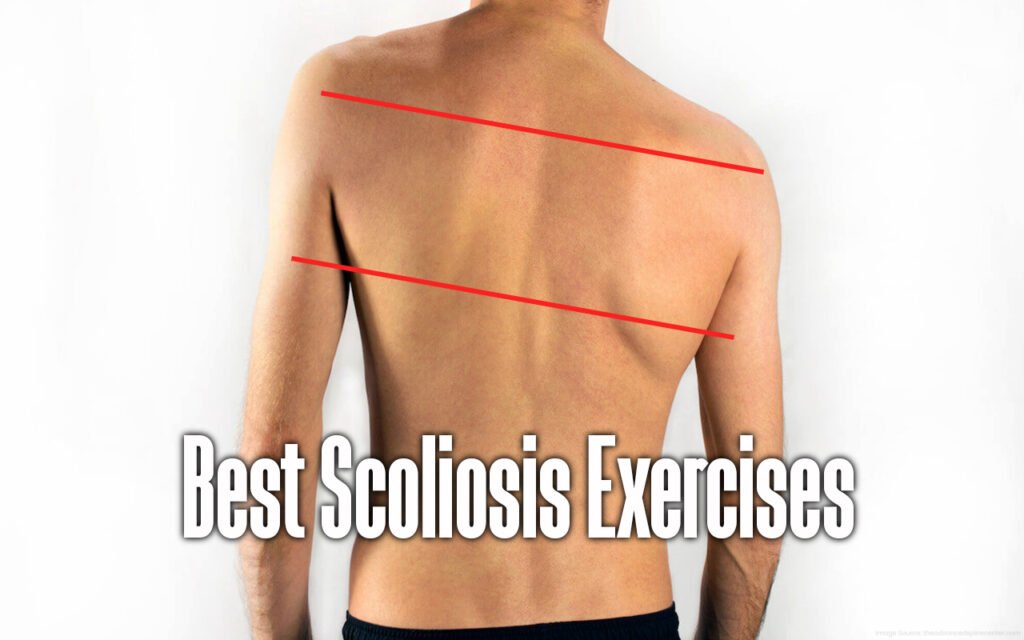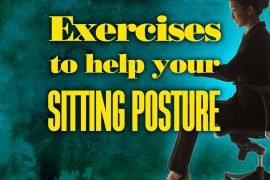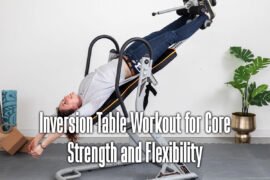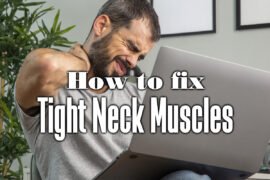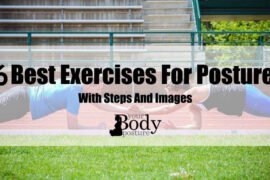Scoliosis is a medical condition in which the spine curves abnormally to either side of the body, disrupting proper posture. Individuals with scoliosis will likely experience distinct amounts of spinal curvature and its location along the spine. Ignoring scoliosis can lead to tight muscles, trigger points, and, eventually, postural issues that are accompanied by significant discomfort. In this post, We will show you the best Scoliosis exercises you can do at home to get relief from scoliosis pain in the spine of your body.
The encouraging news is that mild scoliosis can be remedied in most situations with the correct corrective exercises that fortify the muscles near your spine and shoulders. Are you dealing with back discomfort and fear that it might be scoliosis? If so, this is the post for you. In this article, you’ll discover the facts about scoliosis and how to manage mild cases of it.
What is Scoliosis?
Table of Contents
Scoliosis is a spinal curve sideways instead of the spine’s customary inward and outward curves. This condition manifests as an “S” or “C” shape when viewed from either side. An X-ray diagnosis is required to detect it, and about 3% of people in the US suffer from this condition. Scoliosis has the potential to manifest in a variety of degree levels. Although most cases of childhood spinal deformities are generally mild, they can get worse as the child matures and become disabling.
Such significant curvature in the spine can even impair lung capacity. Oftentimes, these types of cases require more intensive treatment plans administered in medical settings. Conversely, mild scoliosis is not disabling, yet often results in pain due to postural stress. If postural misalignment is left unattended, muscles will inevitably build unbalanced pressure due to the position. This can result in stiffness, tightness, and even pain as certain muscles become excessively contracted while other muscles are overstretched.
How Do You Know if You Have Scoliosis?
A visit to the doctor’s office for an x-ray is the most reliable method of diagnosing scoliosis. Nevertheless, there are certain telltale signs that might indicate you have it including:
- By noticing that your head is not in a centered position between your shoulders, it’s clear to see that they are misaligned.
- Noticeably, one shoulder blade protrudes more than the other, forming a winged scapula.
- Uneven waist, where the gap between arm and torso is more pronounced on one side.
- Unequal hips, with one hip notably higher or more pronounced than the other.
When you look in the mirror, keep an eye out for any of these warning signs that could indicate scoliosis.
Scoliosis Test: “Adam’s Test” Forward Bend Test for Scoliosis
The ‘Adams Test’ is an at-home assessment to detect scoliosis. To accurately perform the Adam’s Test for scoliosis, looking in a mirror or having someone take your picture is best. For optimal viewing, it is advised to wear snug-fitting apparel or go shirtless when performing this test to make your spine and shoulder blades visible in the mirror or photo. To get started, follow these steps:
- Unite your feet and stand tall.
- Lean forward at the waist, bending your torso. Avoid bending at your hips or arching forward to bring your torso closer to your legs. Instead, emphasize bending forward at the waist.
- Allow your arms to hang naturally at the sides of your body and permit gravity to assist you in gently lowering and relaxing your head.
- Have someone take a photo of you or glance in the mirror to view your spine directly from behind.
- It’s easy to detect if you have scoliosis; the condition can be observed in how far forward your body is rounded due to one shoulder appearing higher than the other. By taking a closer look, you can spot the spine and recognize that it is curved instead of remaining perfectly straight.
Types of Scoliosis
Depending on the type of scoliosis present, distinct therapies can be employed to facilitate its correction.
Congenital Scoliosis
Congenital scoliosis is a spinal curvature abnormality that develops while in the womb due to incomplete development of the spine.
Early Onset Scoliosis and Adolescent Idiopathic Scoliosis
Scoliosis is categorized as early-onset when it develops in children up to age 10 after birth. Adolescent idiopathic scoliosis is a condition that develops in adolescents during their growth phases. This condition manifests itself in a cyclical manner with no known root cause.
Degenerative Scoliosis (Adult Onset Scoliosis)
A study revealed that more than 60 percent of adults aged sixty and above are suffering from varying degrees of degenerative scoliosis. Degenerative scoliosis is a condition that develops over time in adults, resulting from the deterioration of spinal discs and joints. The facet joints in your spine allow you to move side-to-side and easily twist.
When the joints become unhealthy, they may not degrade evenly at the hip bones and consequently cause your spine to bend and shift laterally, resulting in scoliosis. Scoliosis in the lumbar spine often manifests this way. In the thoracic area of the spine, “it” (referring to scoliosis) is typically caused by degradation in spinal discs that results in an outward curvature or tilt of certain vertebrae.
Other Diseases or Conditions Can Lead to the Development of Scoliosis
People with certain risk factors, like those mentioned below, may be more likely to suffer from scoliosis and its associated distorted posture:
- Cerebral palsy
- Spinal infections like meningitis
- Spinal injuries
- Congenital disabilities that involve the spine, such as spina bifida
- Muscular dystrophy
Scoliosis Exercises for Muscle Imbalances
Just as conditions like cerebral palsy can result in spinal curvature, the muscular mismatch can also cause curves to form. These discrepancies may result from prior traumas that caused your muscles to adjust to compensate for healing. Alternatively, they could result from unnatural muscle-movement patterns or postures that have been overly repeated until your muscles became “stuck” in a state of tension or overextension. For example, carrying a substantial messenger bag on one side of your body may cause an unnatural tilt in the spine.
Supporting a toddler using your side while holding them just above the hip can be an example of contracting the muscle and then lifting one’s hip, causing a curve in the spine. This article will give insight into the treatment of mild scoliosis. If you are suffering from any other type of the symptoms listed in this article, it is prudent to seek medical advice before attempting any treatment suggested here.
How to Resolve Scoliosis Aroused by Unbalanced Muscles
Mending scoliosis requires frequent workouts, preferably daily, at least twice weekly, to realize continual progress. To begin seeing results, consistency is paramount; retraining your muscles involves time and dedication. By utilizing massage techniques, stretching contracted muscles, and strengthening overstretched ones, these Scoliosis Exercises unlock tension in a highly effective manner. It’s important to remember that everyone with scoliosis will have different levels of curvatures in distinct areas.
Moreover, some individuals will have spines that curve to the left, while others may have a spine that curves in the opposite direction. When dealing with your spine, you may need to tailor the stretches and scoliosis exercises to fit its unique shape. For instance, when performing unilateral scoliosis exercises, you may need to emphasize stretching or exercising one side of your body more than the other. Without delay, let us delve into the Scoliosis Exercises to begin practicing to alleviate the pain of scoliosis and bring your back to a healthier state.
Unlock Scoliosis Pain and Realign Your Spine with Massage Therapy Techniques
Regardless of whether a muscle is too contracted or stretched, this imbalance causes it to become tight and rigid. When muscles are stretched beyond their capacity, they compensate for being unable to contract by becoming tense and inflexible. By receiving massage and trigger point therapy on your back, you can alleviate muscle tension and strain and soften the muscles so they can properly heal themselves, all while improving your scoliosis posture.
1. Use a Massage Ball Against the Wall or Floor
Massage balls offer more focused pressure than foam rollers, allowing you to target specific areas with precision. Combat your own body weight against a wall or the floor to reduce your muscles against the ball and alleviate any tension in those areas of your back where you experience pain, such as above your hip, between shoulder blades, and other regions. If scoliosis is present in your lumbar area, odds are you have tense muscles in the lower back region. This massage ball technique can help you to relax tight muscles that have developed due to scoliosis, which causes the body to be in abnormal positions.
- Relax on your back with your legs bent in a comfortable position.
- Place a massage ball or, even better yet, two lacrosse balls beneath your lower back for improved relief.
- Using your hips, slowly roll the balls in a circular motion along your lower back.
- For maximum relief, press the tender area with your ball for a minimum of 30 seconds before progressing to the next spot.
2. Rejuvenate your spine with a low back stretcher or foam roller
If your spinal curve is located in your spine’s lumbar (lower back) region, then use a soft back stretcher to decompress and stretch it gently. To target your thoracic area of the spine, which is located at chest level, lie down with a foam roller placed under your shoulder blades while on your back. Allow your chest to stretch open, and let the upper back curve over the foam roller.
Let the force of gravity, combined with your body weight, cause a more significant curve in your thoracic spine while stretching for an even deeper sensation. This decompression of the vertebrae in your upper back can help them recover and return to their original condition. It also relieves tension from the nerve roots and spinal discs that could cause severe discomfort.
3. Release Your Lats with a Foam Roller
For those of you with thoracic scoliosis, your large back muscles (known as the lats) under either armpit may be overly tense.
- Position yourself on your side and rest the foam roller beneath your armpit.
- Treat your lat muscle to a deep massage by rolling the foam roller upward and downward the length of your torso.
- When you locate an especially painful area to compress, remain in place on the trigger point and roll your body forward and backward across the foam roller.
Stretches That Fix Scoliosis
Stretching is an effective way to get your blood flowing and support the recovery of muscles that are unbalanced. Stretching elongates overly contracted muscles and relaxes tight and overstretched ones. Here are two stretches you can do daily to help correct scoliosis and relieve back pain.
1. Foam Roller Side Stretch
This exercise will help restore your thoracic spine’s natural lateral curve.
- Lie down on the floor in a side-lying position with your head, shoulders, and bottom arm dangling off the ground. Place a foam roller along your sides for support.
- Allow gravity to draw your bottom arm towards the floor while you let your shoulders and head relax.
- Let your chest and spine stretch and relax for at least 30 seconds in this position, feeling the tension release from your muscles.
2. Exercise Ball Side Stretch
To loosen up the lat muscle, this stretch should be carried out on the side that your upper body is leaning towards. Make sure to perform this exercise daily to relax your lat muscles and potentially reverse scoliosis.
- Recline on a mat, keeping your back straight and even weight distribution between the balls of your feet and both knees.
- Position a large stability ball snugly to the side of your hip where you are experiencing spinal curvature.
- Bend towards the ball until your torso is resting against its side.
- Maintain this posture for thirty seconds and repeat three times to complete one set.
3. Downward-Facing Dog
The downward-facing dog is an iconic yoga posture designed to improve the alignment of your spine. This technique properly aligns your hips and provides a restorative stretch that gently decompresses the spine, improving its posture.
- To get started, assume a forearm plank position with your elbows and feet on the ground while everything else is suspended above. Strive for a straight line from the top of your head to your feet!
- Place one hand beneath your shoulder at a time as though you were beginning a pushup. This will ensure that your body is in proper alignment.
- Lean your weight into your hips, and strive to plant your heels firmly on the ground. Create a triangle with the floor as its base and your glutes at the peak.
- Allow your head to relax in a neutral state, allowing your neck to align properly with the rest of your spine.
- As you stretch your hamstrings, sense the decompression of your spine as it is kept in a straight line by contracting back muscles.
Strength Training Scoliosis Exercises for Mild Scoliosis
By incorporating strength training Scoliosis Exercises into your routine, you can improve the curvature of your spine if you have scoliosis. Adjusting the state of your muscle tissue can realign your spine and improve its support from your muscles. To illustrate, the muscles on both sides of your spine can be toned and built up to assist in keeping the spinal column upright and properly aligned.
1. Foam Roller Back Stability Exercise
Foam rollers are commonly used to alleviate tight muscle tissue and fascia, yet with a 36-inch roller; you can do even more! This exercise will help you achieve the perfect posture by straightening your spine.
- Position the elongated foam roller directly down your back, with it situated beneath your spine. Position your tailbone at one end of the foam roller and place the back of your neck against the other.
- Position your feet firmly on the floor, hip-width apart, and with a slight bend in your knees.
- Maintaining your core tight, draw circles in the air with your arms – first one way and then another.
- Engage your core and rise up one foot, taking flight. Carefully lower one foot and then raise the other. Keep alternating.
2. Hip Bridges
Hip bridges can help to realign misaligned hips and scoliosis in the lower back region. Strengthening the muscles on either side of your lumbar spine and core Scoliosis Exercises help to stabilize and promote an upright posture.
- Recline on a mat with your feet firmly planted and knees gently bent for maximum comfort.
- Tense your glutes and raise your hips from the mat, forming a strong straight line between your shoulders and knees.
- Hold this position for 30 secs or as long as you can manage, then slowly lower yourself back down.
3. Kettlebell Suitcase Deadlifts
Kettlebell suitcase deadlifts target one side of the body, making them an effective tool for correcting scoliosis curvature.
- Position your feet shoulder-width apart.
- Place the kettlebell just outside the foot on the opposite side of your leg’s curved direction.
- Hinge from your hips and keep your knees in line with the tips of your toes.
- Firmly tighten your lat muscles to hold the kettlebell in place and maintain a stationary, neutral spine position.
2. 3-Point Dumbbell Row
Intensify the muscles between your shoulder blades through a single-sided 3-point dumbbell row, which is particularly helpful for people with an outward spinal curve. It’s essential to strengthen and contract these muscles through Scoliosis Exercises such as these.
- Grip a dumbbell in your hand on the side with an outward curving spine. Put the other hand on a bench.
- Adopt a tall stance with your feet shoulder-width apart, and then bend forward from the hips onward.
- As you pull the dumbbell upward, squeeze your shoulder blades together.
- Lower steadily, then repeat for additional reps.
How to Prevent Scoliosis
Slowly progressing postural misalignments, such as scoliosis, are typically caused by the lifestyle habits we’ve repeated for years. By recognizing the origin of adult-onset scoliosis, you can apply preventative measures to avoid its onset. Strengthen your muscles to dodge muscle discrepancies and preserve a healthy spine to avoid scoliosis stemming from spinal disc degeneration. To maintain a healthy backbone, you can stretch, decompress and bolster the muscles holding it.
Scoliosis should always be noticed, even if it appears to be minor. If you have scoliosis brought about by poor posture and muscular discrepancies, the corrective exercises within this post can be utilized to repair the issue over time. In addition to performing these Scoliosis Exercises to fix scoliosis, you should also brush up on how to correct unequal shoulders and how to address a lateral pelvic tilt (uneven hips). These are essential components of rehabilitating your posture. After investigating these conditions, you could discover that you don’t take issue with scoliosis after all. Before attempting any Scoliosis Exercises, make sure to get the green light from your doctor if you have another type of scoliosis or an underlying medical condition.


